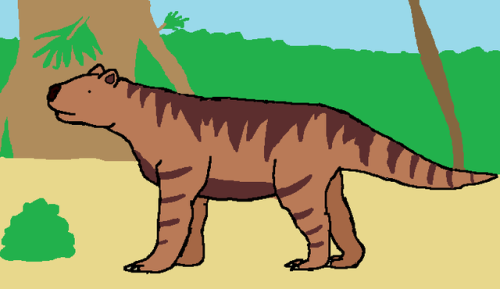#marsupial lion
Thylacoleo carnifex – Early-late Pleistocene (1.6-0.46 Ma)
It’s been a long and very unannounced hiatus, but today is the day it ends. I’ve been extremely busy, but now I’m not. In the meantime, I learned about a fascinating little Australian named Thylacoleo carnifex. It’s commonly known as the marsupial lion, but is a lion in the same way a sea lion is. That is to say, it can hardly be considered a lion at all. It isa marsupial, though, and a member of the same order as kangaroos, koalas, and wombats. There are three total species of Thylacoleo, but T. carnifex is the best understood and most well-known, so I’ll talk about that one.
Australia has been disconnected from every other continent for more than 80 million years, splitting from Antarctica during the Late Cretaceous. During most of the Age of Mammals, metropolitan groups of mammals like cats, rodents, and ungulates (hoofed mammals), were unable to reach it. As a result, the marsupials and monotremes who were already there took over, and things got weird.
Thylacoleo lived during the Ice Age, but isn’t typically what we think of when it comes to Ice Age animals. Australia didn’t witness the huge ice sheets seen in North America and Eurasia, but colder worldwide climates meant Australia’s iconic outback was covered in temperate forests. Thylacoleo lived here. At roughly the size of a small tiger, it was the largest carnivorous mammal to ever live in Australia. It’s shaped roughly like the big cats dominating the rest of the Pleistocene world. This isn’t the only example of convergent evolution with Australian mammals. Palorchestes was another giant marsupial that evolved into something that looked like a tapir. In fact, certain body shapes pop up again and again among isolated ecosystems. Apparently, there is an optimal body plan when it comes to fulfilling certain roles.
ButThylacoleo has a few key differences from its distant feline cousins, and these give clues about its lifestyle. It had a stocky body and big, powerful forelimbs, along with a thick tail. It wasn’t chasing down prey at all, and was probably an ambush hunter that wrestled prey with its front limbs, using its tail for balance. Weirdly enough, it has a lot in common with Smilodon, the saber-tooth cat. Evolution really do be like that sometimes. But there’s something else about this animal, something best explained by showing you. So, now’s the part of the show where it sings us a soulful ballad and—

GOOD LORD WHAT IS HAPPENING IN THERE?
Now, mammals are famous for having weird teeth. Mammal teeth are weird enough that a whole lot of fossil mammals are… just teeth. But Thylacoleo is special. Its incisors were sharpened, acting like the canine teeth of other predatory mammals. Those big rectangular teeth acted like scissor blades for cutting meat and bone. They’re (very) elongated versions of teeth called carnassials. Most carnivorous mammals have a less wild version. If you look inside your dog’s mouth, they’re the two pairs of big, pointed teeth towards the back of their mouths. Cats have them too, but they’re a lot less pronounced.
Having weird-ass teeth like this means their hunting strategy was a little unorthodox. Big cats hunt by sinking their fangs into the neck of their prey, blocking its windpipe until it suffocates. Woof. Thylacoleo couldn’t really do that, thanks to its carnassials. Thylacoleo hunted its prey by crushing the windpipe and spinal cord of its prey with those mouth blades. It also had the strongest relative bite force of any mammal we know of, so it was pretty good at what it did.
So, what happened to the marsupial lion? It went extinct around 50,000 years ago, along with a lot of the other Australian megafauna. That’s probably not a coincidence. Thylacoleo was fantastic at bringing down large prey, but very poorly-adapted to hunting smaller animals. Such heavily specialized animals are often the first to go in extinction events. The Australian climate was beginning to shift as well, beginning to resemble modern Australia. This brought with it all the calamities, big and small, of climate change. Oh, and humans showed up around 60,000 years ago. There is evidence of interaction between Thylacoleo and Aboriginal Australians, in the form of cave paintings of a pouched carnivore. Aboriginal tradition also describes monsters and animals that may have been inspired by Thylacoleo. Methods of farming used by ancient humans may have further destroyed the forests Thylacoleo depended on for hunting, as well.
Thylacoleo is essential to understanding Ice Age Australia. It lived in an ecosystem that doesn’t really exist there anymore, and was specialized in hunting prey that mostly perished alongside it. It showcases both sides of island evolution: The unique traits, as well as the convergent ones. Its extinction marked the end of an era, one dominated by marsupials since the wake of the K-Pg impact event. Australia is still unique today, but there still isn’t a predator around quite like this one.
******************************************************************************
Buy me a Coffee, if you’d like!
Post link

